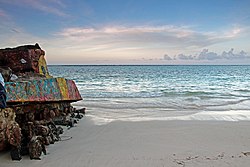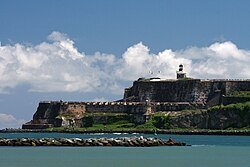This is a list of landmarks in Puerto Rico. These are either tourist attractions, places of interest or famous landmarks located in Puerto Rico. The list is divided among the 78 municipalities of the island.
Contents
- Adjuntas
- Aguada
- Aguadilla
- Aguas Buenas
- Aibonito
- Añasco
- Arecibo
- Arroyo
- Barceloneta
- Barranquitas
- Bayamón
- Cabo Rojo
- Caguas
- Camuy
- Canóvanas
- Carolina
- Cataño
- Cayey
- Ceiba
- Ciales
- Cidra
- Coamo
- Comerío
- Corozal
- Culebra
- Dorado
- Fajardo
- Florida
- Guánica
- Guayama
- Guayanilla
- Guaynabo
- Gurabo
- Hatillo
- Hormigueros
- Humacao
- Isabela
- Jayuya
- Juana Díaz
- Juncos
- Lajas
- Lares
- Las Marías
- Las Piedras
- Loíza
- Luquillo
- Manatí
- Maricao
- Maunabo
- Mayagüez
- Moca
- Morovis
- Naguabo
- Naranjito
- Orocovis
- Patillas
- Peñuelas
- Ponce
- Banks
- Beaches
- Cemeteries
- Churches
- Forests
- Historic homes
- Hotels
- Industries and companies
- Islands
- Lighthouses
- Marinas
- Monuments
- Museums
- Parks
- Schools and colleges
- Sports venues
- Shopping plazas
- Theaters
- Visitor attractions
- Quebradillas
- Rincón
- Río Grande
- Sabana Grande
- Salinas
- San Germán
- San Juan
- Beaches 2
- Bridges
- Castles and fortresses
- Cemeteries 2
- Churches 2
- Government buildings
- Historic districts
- Hotels 2
- Houses
- Libraries
- Lighthouses 2
- Monuments and memorials
- Museums 2
- Music and event venues
- Parks and gardens
- Plazas and squares
- Restaurants
- Schools and universities
- Shopping
- Sports
- Theaters 2
- San Lorenzo
- San Sebastián
- Santa Isabel
- Toa Alta
- Toa Baja
- Trujillo Alto
- Utuado
- Vega Alta
- Vega Baja
- Vieques
- Villalba
- Yabucoa
- Yauco
- See also



















